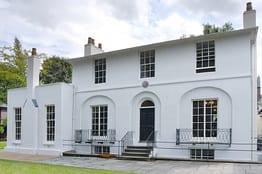Fix citations and format of References
What is an ode?
“A lyric poem typically of elaborate or irregular metrical form and expressive of exalted or enthusiastic emotion.” It is interesting to note that the example for an ode on the definition website is “Ode on a Grecian Urn” by John Keats. This speaks to the fact that Keats is so famous for his work with odes.
What makes Keats’ Odes typically Romantic?
Many of the ideas and themes evident in Keats’s great odes are quintessentially Romantic concerns: the beauty of nature, the relation between imagination and creativity, the response of the passions to beauty and suffering, and the transience of human life in time. The sumptuous sensory language in which the odes are written, their idealistic concern for beauty and truth, and their expressive agony in the face of death are all Romantic preoccupations. (www.keatsian.co.uk)
Why should we explore Keats’ Odes separately from his other works?
While all of Keats’ poetry has his signature spunk, many scholars argue that due to thematic similarities and psychological development among other things, his odes seem to form a group together. The odes do not exactly tell a story–there is no unifying “plot” and no recurring characters–and there is little evidence that Keats intended them to stand together as a single work of art. Nevertheless, the extraordinary number of suggestive interrelations between them is impossible to ignore. However, anyone can read one of the odes and see how well they stand on their own. (www.keatsian.co.uk)
What do the critics say about Keats’ Odes?
There is a noted discrepancy between Keats’ current stellar literary reputation and the initial criticism he received, which was often negative. Scholars who focus on Keats attribute this to a variety of reasons including his class status and political views. Critics appreciate how Keats uses imagination in his poetry to represent beauty as a medium for accessing truth. Modern critics analyze Keats work with traditional techniques commenting on how concrete his imagery appears and the structure of his narratives.
Click below for a slideshow of Keats-related material
https://www.photosnack.com/5CDA7FAD75E/pz9lvasi.html
Did you know?
In Winchester, one can go on a “Keats’ Walk” through the poet’s footsteps and explore the area where he was inspired to write “To Autumn”. This link to a pdf shows the map of the land and includes points of interest. Keats’ Walk Map
Ode to a Nightingale
Ode to Autumn
Ode on a Grecian Urn
Ode on Melancholy
Ode to Psyche
Ode on Indolence
Ode to Apollo
The Wentworth Place was built in 1814 and was occupied by Charles Wentworth Dilke and his family before John Keats took over in 1818. The Wentworth house is where Keats wrote five of his six famous “Ode’s all in the year of 1819.” Located in Hampstead, London, the building is now the site of a Keats museum. The museum is dedicated to memorializing his poetry. This site is also where Keats reportedly fell in love with Fanny Brawne.
Odes of 1819:
In 1819 John Keats wrote five of his most famous “odes.” These odes included “Ode on a Grecian Urn,” “Ode on Indolence,” “Ode on Melancholy,” “Ode to a Nightingale,” and “Ode to Psyche.” Critics cite these poems as some of Keats’ best work. It was in 1819 that Keats decided to devote all of his time and energy to writing poetry. In these odes Keats’ incorporated a style that was quite innovative for his time. This resulted in immediate respect from other acclaimed poets.
Contributors:
Katie Alteri
Dana Ginsberg
Elisabeth McGraw
Jessica Rodio
Ben Cooper
Wentworth house picture:
https://sites.udel.edu/britlitwiki/files//2018/06/OB-EE614_Keats1_D_20090804171037.jpg
Info from:
http://www.keatshouse.cityoflondon.gov.uk/229/History-of-the-house.html
Other references:
www.john-keats.com
www.dictionary.reference.com/browse/ode
www.keatsian.co.uk/revision_notes_contextodes.htm
http://www.visitwinchester.co.uk/site/keats-walk-introduction
http://www.enotes.com/john-keats-criticism/keats-john/introduction
Slideshow References (in order):
http://opioids.com/opium/john-keats.html
https://sites.udel.edu/britlitwiki/files//2018/06/FileJohn_Keats_Signature.jpg
http://winterlief.tumblr.com/post/486434039/distantheartbeats-john-keats-grave-this
http://nospendseptember.blogspot.com/2011/06/thanks-for-clearing-that-up-keats.html
http://www.telegraph.co.uk/culture/books/booknews/5887075/John-Keatss-Hampstead-house-restored.html
http://www.cartoonstock.com/directory/k/keats.asp
https://sites.udel.edu/britlitwiki/files//2018/06/FileKeats_urn.jpg
https://sites.udel.edu/britlitwiki/files//2018/06/FileJohn_Keats_-_To_Autumn_Manuscript_1_unrestored.jpg
https://sites.udel.edu/britlitwiki/files//2018/06/FileA_Day_with_Keats_Neatby_plate_-_Autumn.png
https://sites.udel.edu/britlitwiki/files//2018/06/FilePortrait_of_Keats_listening_to_a_nightingale_on_Hampstead_Heath.jpg
https://sites.udel.edu/britlitwiki/files//2018/06/FileOde_to_a_Nightingale_holograph.jpg
http://mikajaggermorrison.tumblr.com/post/21349382070
http://kureemy.deviantart.com/art/Ode-to-a-Nightingale-114033998

